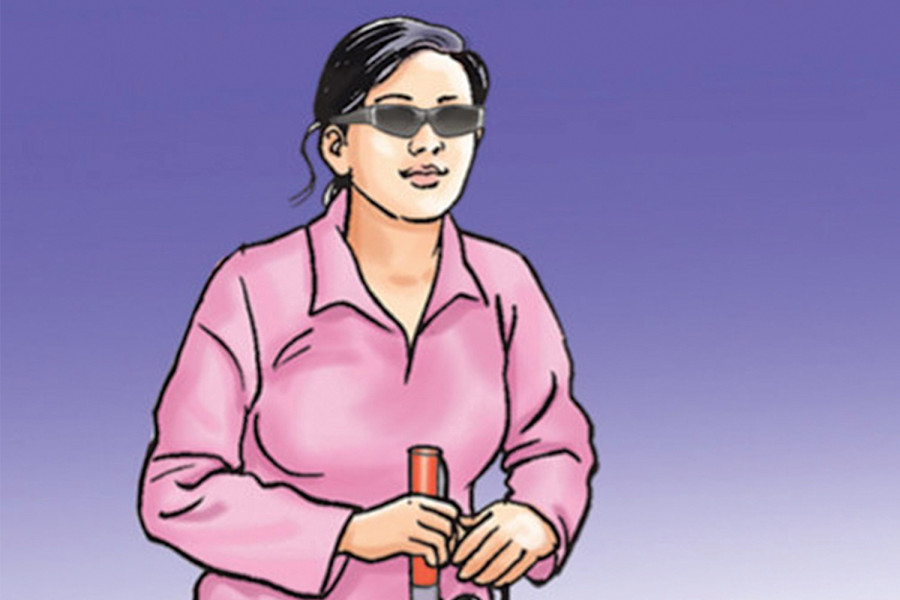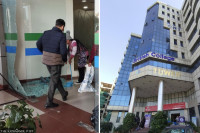National
Women with disabilities struggle to exercise reproductive health rights
Absence of accessible infrastructure and lack of awareness among health workers are some of the hurdles.
Manushree Mahat
Twenty-three-year-old Roshni Lama faced a lot of trouble during her periods when she was at school. Lama uses a wheelchair due to her spinal cord injury. The school and public bathrooms weren’t disability-friendly, and she wasn’t much aware of reproductive hygiene. Today, things have changed for the better. Having attended sexual and reproductive health rights (SRHR) training classes, she is a lot more aware of reproductive hygiene now.
“These days, many young girls and women I come across are much more aware of SRHR than they possibly used to be,” Lama says. These days, there is greater openness about SRHR for women with disabilities, says Lama, who is a basketball player.
Studies have shown that education related to sexual and reproductive health may be even more significant in people with disabilities due to their vulnerability to abuse. However, lack of awareness, alongside the general lack of accessible infrastructure that supports people with disabilities, means that the community struggles with SRHR.
Maintaining menstruation hygiene is often difficult for those who use wheelchairs. Devi Acharya, a board member of the National Spinal Cord Association Nepal, says that many young wheelchair users leave schools in the middle of their studies because they can’t ensure their reproductive hygiene within a limited infrastructure.
“Using diapers is especially difficult when you’re young—they may leak, you have to change them, but without disability-inclusive toilets, there’s little comfort,” says Acharya. “Add menstruation to that, and so many young children are unmotivated to study.”
Many aren’t even aware of SRHR, Acharya adds.
Laxmi Kafle is the mother of a 23-year-old with intellectual disability. She looks after her daughter, who has to spend most of her time at home. Her daughter doesn’t understand anything related to sexual and reproductive health rights. This is the case for many women with disabilities—despite being adults, they haven’t received reproductive education.
“People with disabilities are often looked down upon by society when it comes to sex education,” says Kafle. Their sexual desires are taken as an anomaly, and when questions regarding reproductive health arise, people wonder why someone with disabilities is asking such questions, she says.
People with intellectual disabilities suffer from a lack of access to sexual and reproductive health education. Many people with intellectual disabilities barely leave their houses, and those who do are rarely accepted by society.
“I know a couple who were both intellectually disabled. When they expressed their desire to get married, so many people were judgmental about it,” says Kafle.
Even when people with disabilities express their desire for sex, and marriage with a significant other, it is viewed as something strange.
Forty-one-year-old Rashmi Amatya is an artist. She is hearing-impaired. Her first experience of periods is much like that of her friends and peers—absolute shock paired with horror. She was 13 and had no idea what was going on, but as she grew up and became involved with the disabled community, she gained even more knowledge. She attended classes for disability-inclusive SRHR. Now that she is married, she is also well aware of the use of contraception, and healthy sexual behaviours.
It hasn't been an easy process, though. Doctors tend not to understand her when she wishes to discuss her reproductive health. People sometimes look down upon her and make comments about her disability. But she is not worried—she and her husband live their life on their own terms, and what society thinks of is of little concern to her.
“People will say and think what they want to. I have participated in training on SRHR, and have learned much about my reproductive rights over the years,” says Amatya.
Women with disabilities that the Post talked to said there is greater awareness now about SRHR than ever. However, this awareness may be limited to urban areas, and is highly affected by socioeconomic factors.
People with disabilities in metropolitan areas have better access to roads and infrastructure, although they’re not fully accessible to them. But for people in rural areas, socioeconomic factors, as well as infrastructural problems, pose a major hurdle, says a 2021 study. A whopping 73 percent of the respondents in the study conducted in Ilam revealed their inability to access SRH services in the absence of disability-friendly infrastructure. Of them, 48 percent blamed road issues. Awareness may be increasing, but accessibility is not.
Another common struggle of women with disabilities in accessing reproductive health rights is a general lack of awareness among healthcare workers of how to handle their problems.
Parbati Shrestha has a partial visual impairment. She is married, and is a mother. During her pregnancy, healthcare providers were often rude to her. Instead of making things comfortable for her, they would question her personal choice to have children.
“Every time that I had to visit a hospital, I was assigned a different doctor, and every time I had to explain my disability and situation to them,” says Shrestha, who is also the vice-president of the Blind Youth Association Nepal (BYAN).
Although there isn’t solid research related to maternal mortality in pregnant women, they do show a higher risk of pregnancy-related complications, including preterm term and hypertensive disorders. A major barrier suffered by most pregnant women with disabilities is the lack of accessibility to healthcare, and negative attitudes of healthcare providers towards pregnant women with disabilities. Instead of facilitating comfort, and proper medical care, the negative perception can lead women to not seek prenatal care at all.
“I don’t consider my disability to be as severe as some others have it in the community—those who are fully blind, and have multiple disabilities have it even harder. But even I felt ostracised and frustrated by their behaviour, and to imagine those in the community with severe disabilities suffer worse conditions is disheartening.”
Nepal explicitly recognises the reproductive health rights of people with disabilities. Section 28 (Chapter 8) of the Right to Safe Motherhood and Reproductive Health Act 2018 ensures disability-friendly reproductive services, while Section 29 says there should be no discrimination in relation to reproductive rights on any basis, including disabilities. However, implementing these laws is a different story.
Meena Paudel, vice-chair at the Nepal Disabled Women Association, says that a lack of accessible infrastructure and the need to sensitise healthcare providers pose challenges for many people with disabilities in accessing SRHR services.
“Making posters about SRHR is important, but visually impaired people can’t see it. Talking about it is important, but hearing-impaired people can’t access it,” says Paudel. So, taking an approach that will include everyone is crucial, she says.
According to an official at the Family Welfare Division of the Department of Health Services under the Ministry of Health and Population, they have held discussions and taken measures to make SRHR services more disability-friendly. They plan to provide sign language translators at various hospitals and have approached various departments and divisions about including disability-inclusive SRHR services in their budget. They are also working towards making SRHR products disability-friendly through improvements in reproductive pills and birth control implants injected into arms.
“It’s crucial to make reproductive health services more disability-inclusive, which is why we have been trying to revise our family planning services to be disability-friendly,” says Pahadi. “However, the implementation has been slow.”
The Family Welfare Division with Blind Youth Association Nepal (BYAN) had also published a guideline for disability-friendly SRHR. They are also holding discussions to make training packages for medical personnel to sensitively care for their patients with disabilities.
“I wish more girls with disabilities knew about bad and good sexual behaviour, use of contraception, and reproductive health,” Amatya says. “For women with disabilities, this would go a long way in increasing their quality of life.”




 9.12°C Kathmandu
9.12°C Kathmandu













%20(1).jpg&w=300&height=200)

